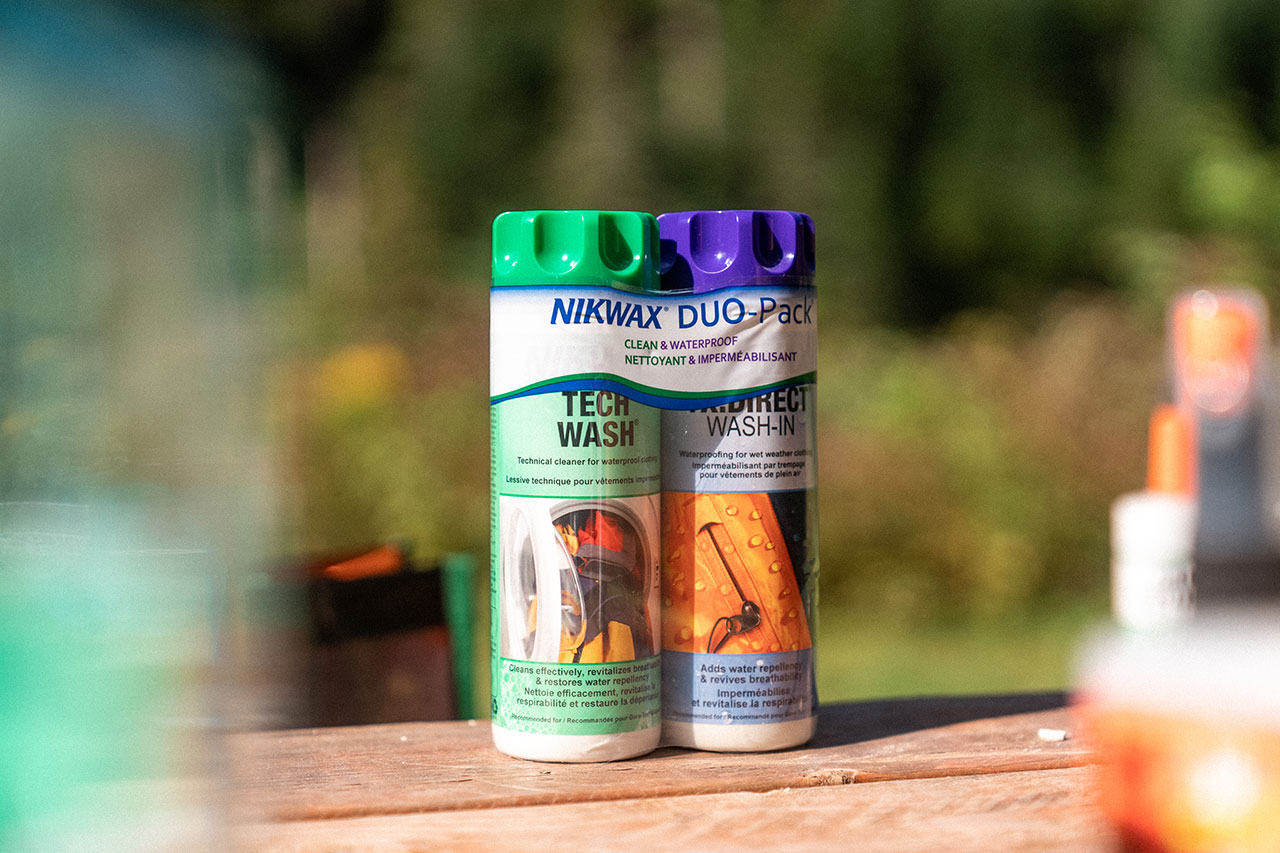Outdoor equipment maintenance
Golden rules for pampering your precious gear
As is the case with every change of season, there's no better time to shower your outdoor equipment with tender loving care. While maintenance should ideally be carried out after each outing throughout the year, the in-between season remains an excellent moment to carry out more important maintenance and, above all, to ensure that what won't be used soon is properly stored away.
By Jean‑Sébastien Massicotte
 Parc national des Hautes-Gorges-de-la-Rivière-Malbaie
Parc national des Hautes-Gorges-de-la-Rivière-Malbaie
"I give my gear a DCA," laughs adventurer Sébastien Lapierre. While he never puts away his tent, sleeping bag, outdoor clothing, and other accessories for very long, the first lone Canadian to reach the South Pole on skis knows how to take good care of his equipment to get the most out of this precious gear and make it last.
Lapierre chortles at the acronym unintentionally formed by the three words he uses as a reminder to keep his equipment in good condition after each outing. "D", "C," and "A" as in "dry", "clean" and "aired." A simple way of remembering the three basic rules he follows to avoid unpleasant surprises.
"The big enemy is humidity," insists Lapierre. Because even for a short time, storing wet gear is a guarantee for mold to appear. "A good way to wreck everything!" warns the polar adventurer, who dries everything meticulously before storing it all in large bins in his heated garage, where everything has its place.
Lapierre favours a cool, dry environment with the most constant temperature possible to avoid condensation and humidity caused by hot-cold cycles.
Benoit Corriveau, owner of the Corivo & Co. agency, which represents MSR and Therm-a-Rest equipment brands, as well as Nikwax cleaning products, fully agrees.
"When it comes to talking storage, I’m the go-to guy," the sales representative explains. And with good reason, he's thinking in particular of products like tents, which are frequently made from polyurethane. "A material that’s sensitive to humidity and heat."
Hence the importance of storing tents and bags made from this material "in a place that’s dry and not too warm," he insists. Otherwise, the material "reacts and degrades, and that's when it becomes sticky." And there's very little to be done once that stage has been reached...
"You just have to take all the time that’s needed to avoid a lot of problems," continues professional guide Gabrielle Pilote, who has her own little cleaning and maintenance routine at the end of each of her outings. "When I come back, I open everything up to dry it properly. Even my floor mattress. Then I check for any cracks or breakage."
It's a question of taking the time to do things right, but also of a space challenge for many, as is the case for the Collège Mérici graduate, who lives in an apartment. "I use bins a lot," points out Gabrielle, who guides for Quatre Natures based in Québec City.
A storage system that allows her to quickly locate her gear between program activities and seasons, while protecting it effectively and minimizing clutter.
In addition to these tips, Sébastien, Benoit, and Gabrielle are also keen to share other advice on the use, maintenance, and storage of various pieces of equipment. Tips that, by extension, apply to other outdoor accessories as well.
1. Tent
For Sébastien Lapierre, there's only one way to dry your tent properly. "Set it up all the way!" Whether in the basement or on the patio when the weather's fine - the dampness of the lawn is to be avoided – pitching the tent this way will let it dry without a hitch. Afterwards, the adventurer stores it in a bin or a large, non-compressive mesh or cotton bag.
When it comes to cleaning, a soft car brush can quickly do most of the work, especially under the floor, especially if a protective tarp or tent footprint hasn’t been used. First with water, then with a mild soap if necessary, on small surfaces one at a time, and then with a toothbrush.
According to Benoit Corriveau, the very best way to make your tent last is quite simple: pitch it to perfection! "It's a material made for extreme conditions," points out the sales representative, who nevertheless insists on the importance of reading the instructions carefully and taking one's time during set up. This will enable you to get the most out of your precious shelter and to avoid premature wear and tear and breakage caused by carelessness.
Another must for Benoit Corriveau is the periodic application of a UV protector to the rainfly and other parts exposed to the sun. This product also renews the waterproofing of the canvas. "We need to prevent wear and tear," he explains. It's a simple application that's done once or twice a season, depending on use. A protection he also applies to backpacks to keep them looking like new for longer.
And if necessary, when it's too late to act, some manufacturers like MSR offer spare parts in case of breakage or marked wear - such as a rainfly - so you don't have to buy a whole new tent.
As for Gabrielle Pilote, her guide training has accustomed her to always having a well-stocked repair kit on hand. In addition to the classic duct tape and tie wrap, she makes sure to have at least one tent pole repair sleeve, a tube that can be slipped over a damaged section. Elastic cable can also be useful for repairs.
2. Hiking boots and shoes
Sébastien Lapierre makes sure to clean his boots and shoes frequently. Using a small brush or a toothbrush, he removes the ubiquitous traces of embedded mud; otherwise such ingrained dirt will eventually dry out the leather and accelerate the detachment of component parts.
In this respect, the Québec-based adventurer appreciates Shoe Goo, a versatile flexible adhesive. He doesn't hesitate to use it whenever a weak spot is detected on his footwear that could accelerate wear. Like the seam between the sole and the edge of a boot, for example. "It acts like a sealant.”
For drying, a fan-equipped boot dryer, easily found in big-box stores, is a super efficient must-have.
Although new boots and shoes are usually properly treated when purchased, Benoit Corriveau points out that this doesn't stay the case forever. Hence the importance of using specialized products to re-waterproof footwear, including those with a Gore-Tex membrane.
"Eventually, microcracks form in the membrane after thousands of repeated flexes," points out Benoit Corriveau. An exterior waterproofing treatment will then help repel infiltration and prevent the materials from becoming saturated with water. The representative suggests using a specialized shampoo to ensure proper cleaning before applying the product.
For her part, Gabrielle Pilote takes great care of her boots, but there comes a time when a little outside help is needed. As with other outdoor equipment repairs, she turns to a shoemaker. "Boots can be repaired," sums up Gabrielle, who was able to breathe new life for another season into a valiant pair of boots that had begun to give up the ghost.
3. Sleeping bag
Here again, drying after use is essential, particularly for down, which is more sensitive to moisture than synthetic fibers. But in both cases, Sébastien Lapierre reminds us to make sure everything is 100% dry before packing. In the wild whenever possible, but especially once you're back home!
And when he talks about airing the gear, he also means not squashing it, an important precaution for sleeping bags that are going to be stored for quite a while. Because although down insulation will regain its loft better than synthetics after being compressed for a long time, it's still advisable to store them in the large mesh or cotton storage bags often supplied with the purchase. Otherwise, hang them in a closet or place them in a bin. "The important thing is to avoid squashing your sleeping bags if at all possible," sums up Sébastien Lapierre. This will extend the life of the bag.
When it comes to cleaning, specialized products always have the edge, reiterates Benoit Corriveau. This is especially striking for down, which can regain much of its original loft with a good cleaning using soap that’s fit for purpose.
And here’s a mistake not to make: avoid dry-cleaning, which will damage the insulating fiber, especially the down. Simply use a large front-mounted washer or one without a central agitator, as well as a good-sized dryer. If need be, a friend who owns a local laundry – or the only one in town – will come to the rescue.
Then, during drying, a few tennis balls added to the bag in the dryer will help break up any wet down balls that may have formed. This recipe also applies to down coats.
4. Coats and waterproof/breathable garments
Sébastien, Benoit, and Gabrielle concur that proper care of technical garments involves using specialized products and following manufacturers' instructions. "It boils down to following the tried-and-true recipe," Benoit Corriveau states simply.
This highlights how detergent-free technical soaps protect waterproof/breathable garments and restore their properties. In particular, they don't leave residues that interfere with the functioning of coatings or membranes, and they don't attack the hydrophobic finish on the garment's surface, the celebrated durable water repellent, or DWR.
And for both the garment and the product used, "the first tip is to read the label," insists Sébastien Lapierre. "It's a good starting point," agrees Gabrielle, who adds that many manufacturers now offer a wealth of information online on how to properly care for clothing and equipment.
In particular, Nikwax has produced a series of videos explaining the maintenance of various equipment, accessible on the brand's YouTube channel.
Which means you don't have to be an expert to waterproof a coat at home that's seen a little too much action and whose surface is soaking up water. Applied by spray or dip, according to the product manufacturer's instructions, waterproofing treatment has proven its worth.
Benoit Corriveau claims that the effect is almost magical. "It breathes new life into Gore-Tex!” At today's equipment prices, that's something to celebrate.
An ounce of prevention is worth a pound of cure
According to the three experts, it's important to act quickly and effectively as the season progresses so as to avoid problems in the wild. Although she usually brings along what she needs to repair a broken shoelace or a leaking rainfly, Gabrielle Pilote believes that prevention is still the best cure.
At the slightest sign of a failing, whether of a sleeping bag or tent buckle, a temperamental coat zipper or a leaky boot seam, don't hesitate to take action.
And for more serious cases that may call for professional repair or warranty service from the manufacturer, autumn is the right moment to take the bull by the horns, according to Benoit Corriveau. "With the holidays just a week away, June 24 is obviously the worst possible time!"
As for Sébastien Lapierre, he suggests taking advantage of this transition period to become more familiar with your gear and to learn how to maintain and repair it. An invaluable asset when problems arise in the faraway wild. He's thinking in particular of anything "mechanical," like a stove, for example, which he can now fully clean and reassemble with his eyes closed... even in the freezing cold of Antarctica. A magic feat the nobody’s asking you to perform!

About Jean-Sébastien Massicotte
A journalist by training and an all-around sports enthusiast, Jean-Sébastien never misses a chance to step up to the plate for a good story. A columnist, photographer, and adventure content creator now based in Quebec City, this Abitibi native has been an outdoor reporter since 2011. Jean-Sébastien collaborates notably with the magazine Espaces.












